


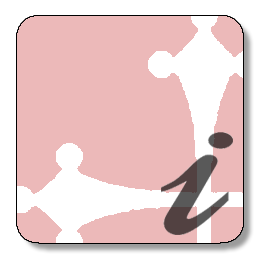
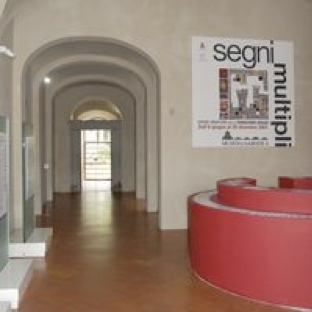 The Museum of Graphic Arts, set up by the Municipality and University of Pisa, is housed in the Palazzo Lanfranchi, one of the most fascinating buildings of the Lungarni (riverfront), formerly a venue for temporary exhibitions.
The museum preserves the Prints and Drawings Collection of the Department of History of the Arts of the University of Pisa, a collection originating in 1957 through an initiative by Carlo Ludovico Ragghianti which has made Pisa a leading centre of knowledge and study of contemporary art.
The Museum of Graphic Arts holds one the most important public collections of contemporary graphic arts. Scholars, students and enthusiasts can enjoy the fruit of extensive artistic research carried out throughout the 20th century, thanks to the critical approach and the great intellectual and moral lesson of personalities such as Timpanaro, Ragghianti and Argan.
The Museum of Graphic Arts, set up by the Municipality and University of Pisa, is housed in the Palazzo Lanfranchi, one of the most fascinating buildings of the Lungarni (riverfront), formerly a venue for temporary exhibitions.
The museum preserves the Prints and Drawings Collection of the Department of History of the Arts of the University of Pisa, a collection originating in 1957 through an initiative by Carlo Ludovico Ragghianti which has made Pisa a leading centre of knowledge and study of contemporary art.
The Museum of Graphic Arts holds one the most important public collections of contemporary graphic arts. Scholars, students and enthusiasts can enjoy the fruit of extensive artistic research carried out throughout the 20th century, thanks to the critical approach and the great intellectual and moral lesson of personalities such as Timpanaro, Ragghianti and Argan.

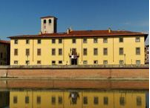 The National Museum of the Palazzo Reale is housed in the 16th-century palazzo of the same name, designed by Buontalenti and for centuries home to the reigning families of the Medici, Lorena and Savoia. The palace was renovated in 2001, when spaces and connections with the adjoining buildings were restored.
Originally meant to preserve artifacts and customs of the Pisan court, the building retains the appearance of a patrician residence containing 17th- to 19th-century furnishings as well as numerous testaments to the families that once resided there: paintings, portraits, tapestries, armour. The Flemish and Florentine tapestries belonging to the Medici are particularly interesting, as is the old armour of the Gioco del Ponte (Game of the Bridge), dating from the 15th and 17th centuries. The valuable predella panel from the polyptych of Saint Nicholas of Tolentino, painted by the young Raphael in 1500, deserves special mention.
The National Museum of the Palazzo Reale is housed in the 16th-century palazzo of the same name, designed by Buontalenti and for centuries home to the reigning families of the Medici, Lorena and Savoia. The palace was renovated in 2001, when spaces and connections with the adjoining buildings were restored.
Originally meant to preserve artifacts and customs of the Pisan court, the building retains the appearance of a patrician residence containing 17th- to 19th-century furnishings as well as numerous testaments to the families that once resided there: paintings, portraits, tapestries, armour. The Flemish and Florentine tapestries belonging to the Medici are particularly interesting, as is the old armour of the Gioco del Ponte (Game of the Bridge), dating from the 15th and 17th centuries. The valuable predella panel from the polyptych of Saint Nicholas of Tolentino, painted by the young Raphael in 1500, deserves special mention.

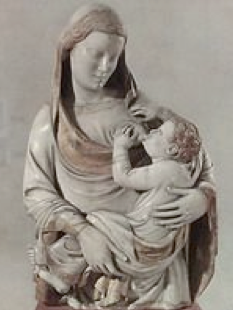 Located in the medieval monastery of the same name near the river Arno, the National Museum of San Matteo boasts a rich series of works by leading Pisan and Tuscan masters of the 12th-17th centuries and a flourishing collection of archaeological and ceramic artifacts. The quantity and value of the exhibits make the San Matteo one of the most important European museums in the field of medieval art.
12th- and 13th-century painting is represented by the Croci dipinte (painted crosses), all derived from Pisa’s oldest churches, with works by Berlinghiero Berlinghieri, Giunta Pisano and the Master of San Martino.
The 14th- and 15th-century painting section features works by Francesco di Traino, Lippo Menni, Buonamico Buffalmacco, Spinello Aretino, Taddeo di Bartolo and other great painters of the period. Further 15th-century exhibits include works by Masaccio, Gentile da Fabriano, Beato Angelico, Benozzo Gozzoli and Domenico Ghirlandaio, glazed earthenware from the Della Robbia workshop and the renowned bust-relic of Saint Luxorius, by Donatello.
Simone Martini’s polyptych, from the Church of Santa Caterina d’Alessandria, a Nativity by Tino di Camaino and the Madonna del Latte (Breastfeeding Madonna) by the brothers Andrea and Nino Pisano are considered masterpieces of 12th-15th century Pisan sculpture.
The museum also preserves important low relief wooden sculptures. 13th- and 14th-century items include works by the Sienese Francesco di Valdambrino.
The illuminated manuscripts section contains pieces from the 12th-14th centuries, including the illustrated bible Bibbia di Calci, dating from 1168.
There is also a noteworthy collection of medieval Pisan and Islamic ceramic basins that were once used to decorate the outside walls of Pisan churches, attesting to the commercial relationships existing between the Maritime Republic and the North African countries.
Located in the medieval monastery of the same name near the river Arno, the National Museum of San Matteo boasts a rich series of works by leading Pisan and Tuscan masters of the 12th-17th centuries and a flourishing collection of archaeological and ceramic artifacts. The quantity and value of the exhibits make the San Matteo one of the most important European museums in the field of medieval art.
12th- and 13th-century painting is represented by the Croci dipinte (painted crosses), all derived from Pisa’s oldest churches, with works by Berlinghiero Berlinghieri, Giunta Pisano and the Master of San Martino.
The 14th- and 15th-century painting section features works by Francesco di Traino, Lippo Menni, Buonamico Buffalmacco, Spinello Aretino, Taddeo di Bartolo and other great painters of the period. Further 15th-century exhibits include works by Masaccio, Gentile da Fabriano, Beato Angelico, Benozzo Gozzoli and Domenico Ghirlandaio, glazed earthenware from the Della Robbia workshop and the renowned bust-relic of Saint Luxorius, by Donatello.
Simone Martini’s polyptych, from the Church of Santa Caterina d’Alessandria, a Nativity by Tino di Camaino and the Madonna del Latte (Breastfeeding Madonna) by the brothers Andrea and Nino Pisano are considered masterpieces of 12th-15th century Pisan sculpture.
The museum also preserves important low relief wooden sculptures. 13th- and 14th-century items include works by the Sienese Francesco di Valdambrino.
The illuminated manuscripts section contains pieces from the 12th-14th centuries, including the illustrated bible Bibbia di Calci, dating from 1168.
There is also a noteworthy collection of medieval Pisan and Islamic ceramic basins that were once used to decorate the outside walls of Pisan churches, attesting to the commercial relationships existing between the Maritime Republic and the North African countries.

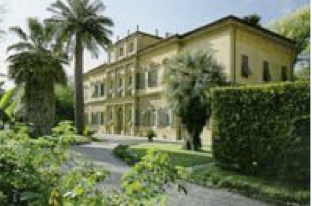 Pisa's Botanic Museum is housed in a small 18th-century building inside the Botanic Garden.
The facade is richly decorated with embedded shells and coloured stones and is quite striking as seen from the Garden.
The museum is a compilation of collections among which particular importance is ascribed to the herbals, collections of pressed and dried plants fixed on sheets of paper and accompanied by information about the plant itself as well as details of where and when it was found.
Some of the collections are considered closed, that is, for historical reasons they cannot be added to.
It appears that the practice of drying and preserving plants for educational and scientific purposes originated at the University of Pisa; the method was adopted in the 16th century, progressively replacing the tradition of drawing.
The museum also includes a historical hall preserving a series of portraits of the directors of the Botanic Garden. The paintings are of special historical and scientific interest in that they often depict imported plants, allowing experts to determine when they were imported.
Of considerable interest is the collection of wax models made by Luigi Calamai in 1831, almost two hundred of them reproducing mushrooms.
(Text taken from Pisa's municipal government website)
Pisa's Botanic Museum is housed in a small 18th-century building inside the Botanic Garden.
The facade is richly decorated with embedded shells and coloured stones and is quite striking as seen from the Garden.
The museum is a compilation of collections among which particular importance is ascribed to the herbals, collections of pressed and dried plants fixed on sheets of paper and accompanied by information about the plant itself as well as details of where and when it was found.
Some of the collections are considered closed, that is, for historical reasons they cannot be added to.
It appears that the practice of drying and preserving plants for educational and scientific purposes originated at the University of Pisa; the method was adopted in the 16th century, progressively replacing the tradition of drawing.
The museum also includes a historical hall preserving a series of portraits of the directors of the Botanic Garden. The paintings are of special historical and scientific interest in that they often depict imported plants, allowing experts to determine when they were imported.
Of considerable interest is the collection of wax models made by Luigi Calamai in 1831, almost two hundred of them reproducing mushrooms.
(Text taken from Pisa's municipal government website)

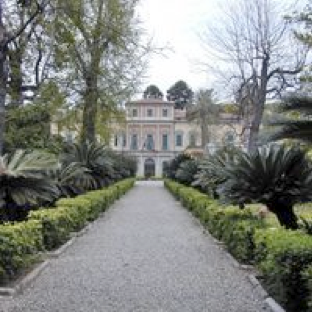 The Botanic Garden of Pisa university was created in 1543 through the work of the physician and botanist Luca Ghini. It is the oldest university botanic garden in Europe.
Originally situated in the area of the Medici Arsenals, in 1563 it was transferred to the north-west portion of Pisa's historic centre; in 1591 it was moved to its current location.
In the 1800s the 16th-century layout was dismantled in favour of a more 'scientific' arrangement of the flower-beds.
The Garden premises enclose the Botanic Institute and the Botanic Museum.
Worthy of mention among the various sections and collections are: the Arboretum, with trees of the conifer and amentifer groups: the 'Orto del Mirto' (Myrtle Garden) with some 140 species of medicinal plants; the collection of aquatic plants, made up of indigenous species which once characterized Tuscany and are now on the brink of extinction; the flora faraonica, comprising plants which in ancient Egypt were cultivated for food, medicine and cosmetics; the systematic collection (approx. 550 species belonging to 39 families); the Greenhouse of Succulent Plants (Cactaceae, Euphorbiaceae, Crassulaceae, and specimens of aloe and agave). In the Cedar Gardens live the two oldest trees of the entire complex: a Magnolia grandiflora and Ginkgo biloba, both planted in 1787.
The Botanic Garden of Pisa university was created in 1543 through the work of the physician and botanist Luca Ghini. It is the oldest university botanic garden in Europe.
Originally situated in the area of the Medici Arsenals, in 1563 it was transferred to the north-west portion of Pisa's historic centre; in 1591 it was moved to its current location.
In the 1800s the 16th-century layout was dismantled in favour of a more 'scientific' arrangement of the flower-beds.
The Garden premises enclose the Botanic Institute and the Botanic Museum.
Worthy of mention among the various sections and collections are: the Arboretum, with trees of the conifer and amentifer groups: the 'Orto del Mirto' (Myrtle Garden) with some 140 species of medicinal plants; the collection of aquatic plants, made up of indigenous species which once characterized Tuscany and are now on the brink of extinction; the flora faraonica, comprising plants which in ancient Egypt were cultivated for food, medicine and cosmetics; the systematic collection (approx. 550 species belonging to 39 families); the Greenhouse of Succulent Plants (Cactaceae, Euphorbiaceae, Crassulaceae, and specimens of aloe and agave). In the Cedar Gardens live the two oldest trees of the entire complex: a Magnolia grandiflora and Ginkgo biloba, both planted in 1787.